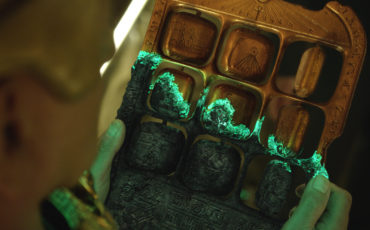
Computer Graphics World: Dirty Sets, Nasty Weapons
As Dastan and Tamina journey through sixth-century Persia on their mission to save the Sands of Time, they travel through two cities, which house several action sequences.
Sets built on location in the Atlas Mountains gave the actors walls and rooftops to climb and jump from, and gave the postproduction team lighting reference, but these partially built cities had one problem. “They were too clean,” says Matt Kasmir, 2D supervisor at Cinesite. “As our lighting and displacement map work progressed, we found we often had to replace the original sets with 3D because our level of ageing and destruction looked better. Nine times out of ten when the director said he didn’t like something, he was pointing to something in camera, not CG. That made us feel good.”
To build the cities, the crew started with two sets of 30 generic building blocks, some basic cubes for simple houses and others six stories tall created in Maya, as well as several props. From these, they created cities with 1000 buildings – one a rich city with painted walls, the other rougher and more organic-looking.
“We had a great level of detail in the displacements, textures, and staining, which the lighters can use at their discretion,” Kasmir says. “We also had a selection of windows, doors and props to differentiate the buildings, and we’d intersect buildings to create new ones. If you push a small building into the side of a larger one, suddenly you have a new building with a portico.”
To populate the cities with people walking in the streets, cooking outdoors, and so forth, the crew used Massive’s software. Particles generated in Side Effects Software’s Houdini added smoke to the cooking fires.
To make the action sequences believable, Cinesite put weapons in the actors’ hands, and created wounds with digital prosthetics. The weapons ranged from swords, daggers and arrows to whips. The artists filled hilts held by the actors with swords and daggers, and sent arrows flying on curves created in Maya and imported into Nuke. “We let the compositors animated the arrows,” Kasmir says. “We imported the geometry for an arrow and its corresponding UV map, and let the compositors play around with the trajectory. Because we had 3D geometry, we could see where the arrow as in 3D space in the comp.”
As for the whips, a stuntman practiced with real whips, but he replaced the whips with handles for filming. “That conjured up loads of animation problems,” Kasmir says. “He got more flamboyant wen he used only the handles and they filmed the sequence at 48 frames per second.” So, to animate the whips more effectively, they retimed the shots to 24 fps, animated the whips, and then retimed them again to the slow-motion 48 fps. One whip had spinning metal weights at the end, and other had a claw-like end, so the riggers set up separate systems for the tips and the whips.
“We animated the whips on a per-shot basis,” Kasmir says. “We placed the tips and made them look dangerous, and then we did something interesting with the leather whips.”




